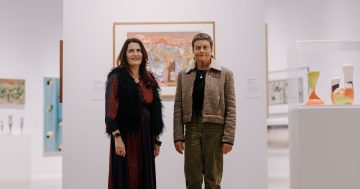
Illawarra historian Frank McCaffrey. From the collections of Wollongong City Libraries and the Illawarra Historical Society – P03/P03998.
For too long, pioneer Illawarra historian Frank McCaffrey has been regarded simply as a deranged antiquarian whose main historical interest in life was the sex lives of what became known as the Australian Illawarra Shorthorn (AIS) breed of cattle.
But what anyone who wades through McCaffrey’s accumulated scribbled notes about the early history of Illawarra soon realises, is that despite having to digest way too much information about bovine creatures, he knew a hell of a lot of stuff about Illawarra that no-one else did.
So while living in late 19th and early 20th century Illawarra, industriously charting the bloodlines at every single cattle sale for which he could find a record, McCaffrey basically compiled his definitive private Illawarra stud book.
In short, he is Illawarra’s pioneer family historian – but focussed a touch more on the families of cows than people. Nonetheless, he came up with one extremely sexy local story about a man putting his wife up for sale.
But to get to that story one first has to read McCaffrey rambling on interminably about the bloodline of cows in lllawarra’s milking herds and which bull could claim paternity.
Thanks to McCaffrey’s obsession, he was able to help market a distinctly local breed of dairy cow – the Australian Illawarra Shorthorn. And while not quite so highly prized as a milker today, this breed was once regarded as something of the ants pants in the milking world.
Today, however, it is often less necessary to know such things or for cows to even have to engage in traditional sex. In vitro fertilisation (IVF) is now often the go, so having a prize bull at every local dairy has often become superfluous.
But back in late 19th and early 20th century Illawarra it could matter whose parents your cow had because owning a prize cow or bull could sometimes earn big money.
So McCaffrey’s endless charting of the bloodlines at every cattle sale for which he could find a record was not quite so silly as it might seem.
Yet having long cursed at McCaffrey’s often illegible handwriting (today held in reams at the University of Wollongong Archives), I’ve learnt to have greater respect for this rather sad man and now judge him to be Illawarra’s finest historian.
McCaffrey’s advantage above all others is that he was born at a time when some of the earliest of the white invaders in Illawarra were still alive (or at least the children to whom they told stories of their early lives were still living).

McCaffrey was dedicated to recording the bloodlines of Illawarra’s cattle. Photo: Supplied.
So if his informants got it right about early Illawarra, then McCaffrey did too. And if he had been spun a line then he most likely sometimes got it wrong. But, best of all, McCaffrey had access to memories that are today available from no other source.
An example that sounded unlikely to have ever occurred was when McCaffrey claimed a wife auction had taken place in the middle of Crown Street Wollongong in the 1840s.
“The owner put a halter round her neck and led her into the street. She brought £2. I could give the names of seller and buyer, but won’t do. The woman made a good wife for the other man.”
Coy as he was trying to be, I found that among McCaffrey’s scribbled notes he did leave a couple of clues.
The seller, revealed McCaffrey, was known as “Billy the Barber” and the purchaser was a man named “Beadle”.
After a bit of my own research I found out the only likely Wollongong suspect was “James Beadle”.
But that didn’t help, for how could I ever find the name of the wife who was put up for sale when she couldn’t legally re-marry because she had been sold rather than divorced? All I could find was that James Beadle moved from Wollongong to Molong NSW after the auction.
So I alerted my friend Lorraine Neate to the name of the purchaser and, as a very skilled family historian, Lorraine quickly came up with the goods.
The seller turned out to be barber William Elford who had been assigned as convict to Alexander Elliot at Wollongong.
Lorraine thus confirmed Ann Gwynne, transported in 1838 for robbery, later became known as “Ann Beadle” who lived happily ever after at Molong NSW with her purchaser James Beadle and his brother Samuel.
So who now says that deranged Illawarra historians obsessed with the sex lives of Wollongong cows (and sometimes people) can’t tell us stuff that seems stranger than fiction but turns out to be right on the money?


















